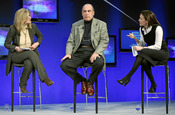A corporation's goals and policies are established by the chief executive officer in collaboration with other top executives, who are overseen by a board of directors. In a large corporation, the chief executive officer meets frequently with subordinate executives to ensure that operations are conducted in accordance with these policies. The chief executive officer of a corporation retains overall accountability; however, a chief operating officer may be delegated several responsibilities, including the authority to oversee executives who direct the activities of various departments and implement the organization's policies on a day-to-day basis. In publicly held and nonprofit corporations, the board of directors ultimately is accountable for the success or failure of the enterprise, and the chief executive officer reports to the board.
Topics of communication may include: the company's mission and values, as well as safety tips, articles about new employees, and coverage of company policy.
Chief financial officers direct the organization's financial goals, objectives, and budgets.
They oversee the investment of funds and manage associated risks, supervise cash management activities, execute capital-raising strategies to support a firm's expansion, and deal with mergers and acquisitions.
Topics of communication may include: Pay, health plans, travel expenses and retirements plans
Chief information officers are responsible for the overall technological direction of their organizations. They are increasingly involved in the strategic business plan of a firm as part of the executive team. To perform effectively, they also need knowledge of administrative procedures, such as budgeting, hiring, and supervision. These managers propose budgets for projects and programs, and make decisions on staff training and equipment purchases. They hire and assign computer specialists, information technology workers, and support personnel to carry out specific parts of the projects. They supervise the work of these employees, review their output, and establish administrative procedures and policies. Chief information officers also provide organizations with the vision to master information technology as a competitive tool.
Topics of communication may include: special projects, IT employee reviews, project budgets and policies and procedures for IT employees.
The director of human resources may oversee several departments, each headed by an experienced manager who most likely specializes in one personnel activity, such as employment, compensation, benefits, training and development, or employee relations.
Topics of communication may include: employee performance, salary increases, layoffs, counseling, and benefits.
http://www.bls.gov/oco/ocos012.htm http://www.inc.com/magazine/19950801
http://www.cfo.com http://www.workforce.com/index.html



Good essay. : )
A conclusion is needed.
Citations not in MLA or APA format.
4 out of 4 people found this comment useful.